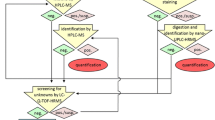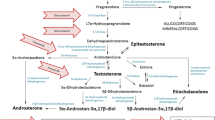Abstract
Influencing the endurance in elite sports is one of the key points in modern sports science. Recently, a new class of prohibited substances reached in the focus of doping control laboratories and their misuse was classified as gene doping. The adenosine monophosphate activated protein kinase activator 5-amino-4-imidazolecarboxyamide ribonucleoside (AICAR) was found to significantly enhance the endurance even in sedentary mice after treatment. Due to endogenous production of AICAR in healthy humans, considerable amounts were present in the circulation and, thus, were excreted into urine. Considering these facts, the present study was initiated to fix reference values of renally cleared AICAR in elite athletes. Therefore a quantitative analytical method by means of isotope-dilution liquid chromatography (analytical column: C6-phenyl) coupled to tandem mass spectrometry, after a sample preparation consisting of a gentle dilution of native urine, was developed. Doping control samples of 499 athletes were analysed, and AICAR concentrations in urine were determined. The mean AICAR value for all samples was 2,186 ng/mL with a standard deviation of 1,655 ng/mL. Concentrations were found to differ depending on gender, type of sport and type of sample collection (in competition/out of competition). The method was fully validated for quantitative purposes considering the parameters linearity, inter- (12%, 7% and 10%) and intraday precision (14%, 9% and 12%) at low, mid and high concentration, robustness, accuracy (approx. 100%), limit of quantification (100 ng/mL), stability and ion suppression effects, employing an in-house synthesised 13C5-labelled AICAR as internal standard.

Urinary AICAR concentrations (ng/mL)




Similar content being viewed by others
References
Narkar VA, Downes M, Yu RT, Embler E, Wang YX, Banayo E, Mihaylova MM, Nelson MC, Zou Y, Juguilon H, Kang H, Shaw RJ, Evans RM (2008) AMPK and PPARdelta agonists are exercise mimetics. Cell 134:405–415
Thevis M, Thomas A, Kohler M, Beuck S, Schänzer W (2009) Emerging drugs: mechanism of action, mass spectrometry and doping control analysis. J Mass Spectrom 44:442–460
Barre L, Richardson C, Hirshman MF, Brozinick J, Fiering S, Kemp BE, Goodyear LJ, Witters LA (2007) Genetic model for the chronic activation of skeletal muscle AMP-activated protein kinase leads to glycogen accumulation. Am J Physiol Endocrinol Metab 292:E802–E811
Goodyear LJ (2008) The exercise pill—too good to be true? N Engl J Med 359:1842–1844
WADA. http://www.wada-ama.org/rtecontent/document/2009_List_En.pdf. Accessed Nov 2009
Marie S, Heron B, Bitoun P, Timmerman T, Van Den Berghe G, Vincent MF (2004) AICA-ribosiduria: a novel, neurologically devastating inborn error of purine biosynthesis caused by mutation of ATIC. Am J Hum Genet 74:1276–1281
Baggott JE, Morgan SL, Sams WM, Linden J (1999) Urinary adenosine and aminoimidazolecarboxamide excretion in methotrexate-treated patients with psoriasis. Arch Dermatol 135:813–817
Hornik P, Vyskocilova P, Friedecky D, Adam T (2006) Diagnosing AICA-ribosiduria by capillary electrophoresis. J Chromatogr B Analyt Technol Biomed Life Sci 843:15–19
Schlimme E, Boos KS, Hagemeier E, Kemper K, Meyer U, Hobler H, Schnelle T, Weise M (1986) Direct clean-up and analysis of ribonucleosides in physiological fluids. J Chromatogr 378:349–360
WADA. http://www.wadaama.org/rtecontent/document/TD2009NA_2010_v1.0_EN_FINAL.pdf. Accessed Nov 2009
Saito Y, Zevaco TA, Agrofoglio LA (2002) Chemical synthesis of C-13 labeled anti-HIV nucleosides as mass-internal standards. Tetrahedron 58:9593–9603
Kohyama N, Yamamoto Y (2003) A facile synthesis of AICAR from inosine. Synthesis-Stuttgart 2639–2642
Matuszewski BK, Constanzer ML, Chavez-Eng CM (2003) Strategies for the assessment of matrix effect in quantitative bioanalytical methods based on HPLC-MS/MS. Anal Chem 75:3019–3030
Azzalini A, Capitanio A (1999) Statistical applications of the multivariate skew normal distribution. J Roy Statist Soc 61:579–602
Neter J, Wasserman W, Kutner MH, Nachtsheim C (2005) Applied linear statistical models, 4th edn. WCB McGraw-Hill, Boston
Dixon R, Fujitaki J, Sandoval T, Kisicki J (1993) Acadesine (AICA-riboside): disposition and metabolism of an adenosine-regulating agent. J Clin Pharmacol 33:955–958
Dixon R, Gourzis J, McDermott D, Fujitaki J, Dewland P, Gruber H (1991) AICA-riboside: safety, tolerance, and pharmacokinetics of a novel adenosine-regulating agent. J Clin Pharmacol 31:342–347
Acknowledgments
The study was carried out with the support of the Manfred Donike Institute for Doping Analysis, Cologne, Germany, the Federal Ministry of the Interior of the Federal Republic of Germany and the Federal Office of Sports, Bern, Switzerland.
Author information
Authors and Affiliations
Corresponding author
Rights and permissions
About this article
Cite this article
Thomas, A., Beuck, S., Eickhoff, J.C. et al. Quantification of urinary AICAR concentrations as a matter of doping controls. Anal Bioanal Chem 396, 2899–2908 (2010). https://doi.org/10.1007/s00216-010-3560-8
Received:
Revised:
Accepted:
Published:
Issue Date:
DOI: https://doi.org/10.1007/s00216-010-3560-8




